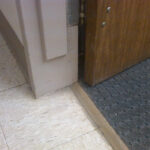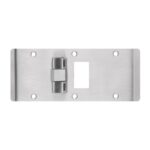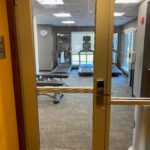In January of this year, I wrote about a tragic fire at a senior home in L’Isle Verte, Quebec, in which 32 of the home’s residents were killed. The inquest into this incident is currently underway, and I’ve been keeping an ear to the ground to see if there are any lessons to share.
It was recently revealed that the home’s front door was equipped with a “special latch” to keep the home’s residents with dementia inside, since at least 2 residents had been found wandering outside in the past. The plan was to remove the lock if the fire alarm was actuated. According to news reports the lock was not removed, and it prevented people from exiting on the night of the fire. This seems like a good time for a refresher on locking egress doors in health care facilities.
 While controlled egress is allowed in some health care facilities according to the International Building Code (IBC) and NFPA 101 – The Life Safety Code, there are requirements that must be followed to ensure the safety of the building’s occupants. The 2015 IBC lists the following in section 1010.1.9.6 (consult NFPA 101 for the requirements specific to the Life Safety Code):
While controlled egress is allowed in some health care facilities according to the International Building Code (IBC) and NFPA 101 – The Life Safety Code, there are requirements that must be followed to ensure the safety of the building’s occupants. The 2015 IBC lists the following in section 1010.1.9.6 (consult NFPA 101 for the requirements specific to the Life Safety Code):
- The 2015 edition of the IBC limits the use of controlled egress locks to I-1 and I-2 occupancies; the 2009 and 2012 edition limited their use to I-2 occupancies.
- In these occupancies, doors may be locked in the direction of egress using electric locks / electromagnetic locks, in areas where the clinical needs of patients require their containment. BUT…the following requirements must be met.
- The building must be equipped throughout with an automatic sprinkler system, or an automatic smoke or heat detection system.
- Door locks must unlock upon actuation of the sprinkler or fire detection system.
- Door locks must unlock upon loss of power controlling the lock.
- Door locks must have the capability of being unlocked by a remote switch at the fire command center, a nursing station, or other approved location. The switch must directly break power to the lock.
- Only one door equipped with a controlled egress lock must be encountered in an occupant’s egress path before entering an exit.
- Procedures for unlocking the doors must be part of the emergency plan.
- All clinical staff must have the ability and credentials (card, fob, code, key, etc.) required to operate the locks.
- Emergency lighting is required at the door location.
- Locking system must be listed per UL 294.
Exceptions: For patients who require restraint or containment as part of a psychiatric treatment area, the doors are not required to unlock automatically upon actuation of the sprinkler / fire alarm, or upon loss of power, or via the remote switch. The limitation on the number of controlled egress locks in the egress path does not apply to these facilities. In the 2015 edition of the IBC, these exceptions have also been added for doors in nursery and obstetric areas where a listed egress control system is used to prevent child abduction.
To meet the requirements of the section on controlled egress, fail safe electrified locks must be used. Electromagnetic locks are inherently fail safe – they unlock when power is removed, so they are frequently used for this application. If all of the criteria listed above are met, an electromagnetic lock used in this situation is not required to have the other release devices (sensor and push button, or door-mounted hardware with switch) that are typically required for mag-locks.
A fail-safe system of this type, along with proper planning and training, can help to protect patients from leaving the unit unaccompanied, while also providing for their life safety and egress if a fire occurs. These requirements first appeared in the 2009 edition of the IBC and have been refined over the 2012 and 2015 editions, so consult the appropriate edition and your AHJ for information specific to your project’s jurisdiction.
You need to login or register to bookmark/favorite this content.







Leave A Comment